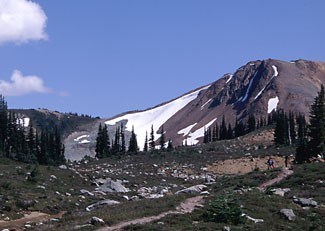This winter Whistler-Blackcomb will open the Flute Bowl area to the public, bringing signage, avalanche control and ski patrol sweeps to an area that was previously in Whistler’s backcountry.
As long as they don’t decide to add a new chairlift, which was included in an earlier expansion plan, most park advocacy groups say they can live with the expansion.
"The Whistler Alpine Club strongly supports maintaining Flute Bowl as a liftless area," said Bryce Leigh, the Whistler Alpine Club’s access and environment director. "(The club) is very concerned that this liftless expansion is only a stepping stone to a lift being installed on Flute."
Whistler-Blackcomb has always had tenure over Flute Peak, but only acquired tenure over the lower section in 2002 as part of a land swap with B.C. Parks. Various groups, including Sea to Sky Parkwatch and the Whistler Alpine Club, were opposed to the land swap because of the impact that the new lift would have on the wilderness values of the park.
The new Flute expansion, which will add more than 700 acres of skiable terrain to Whistler Mountain, is being touted as a backcountry experience for customers who might not mind a 15 to 20 minute walk to get to fresh powder.
Whistler-Blackcomb has not ruled out building a lift in the future, but for now they are looking to create a unique and safe backcountry experience for guests.
"Flute and its adjacent peaks have very sensitive alpine ecosystems that would be compromised by lift facilities," said Bob Brett, a local alpine ecologist and a member of Sea to Sky Parkwatch. "Although we are cautiously optimistic that Whistler-Blackcomb’s announcement signals their desire to make the area safe while protecting the environment, we would prefer a categorical statement from Whistler-Blackcomb that they will never put a lift in the area.
Some of the reasons why the Whistler Alpine Club and Sea to Sky Parkwatch are opposed to a new lift include:
• The negative visual impact that a lift would have during the summer months, when the area is a popular hiking destination.
• The fragile ecosystem would be damaged by the construction of new roads and the lift system.
• The new lift would diminish the summer and winter backcountry experience for users.
"We recognize Whistler-Blackcomb’s concern about avalanche safety in Flute Bowl, and understand the benefits to the lift company of including Flute in its controlled area. However, even a liftless expansion will increase the number of users and presence of snowcats, and will therefore impact the environment," said Brett.
"We urge Whistler-Blackcomb to keep their footprint in the Flute area as small as possible, especially by preventing further lift development."
Local astronomer John Nemy from the Pacific Observatory said his main concern with the expansion is the potential impact to the beauty of the area.
"The Musical Bumps is one of the most historical and spectacular high alpine ridge walks in the world, but we are in danger of losing it," said Nemy.
"Whistler-Blackcomb and Intrawest have an amazing opportunity to take what we have learned from the rest of the world and properly protect our spectacular natural environment. The opportunity is to recognize this asset and to properly promote and gently develop the tourist experience in the backcounty. It could be a huge, sustainable, win-win for everyone."
In addition to the Flute expansion, Whistler-Blackcomb is working to open the Peak to Creek area to the public this winter. It will also be a liftless expansion in the beginning, but the company has not ruled out the possibility of adding a new lift or lifts in the future.
Together, these two expansions will add about 1,100 acres of skiable terrain, or another 30 per cent, to Whistler Mountain.




